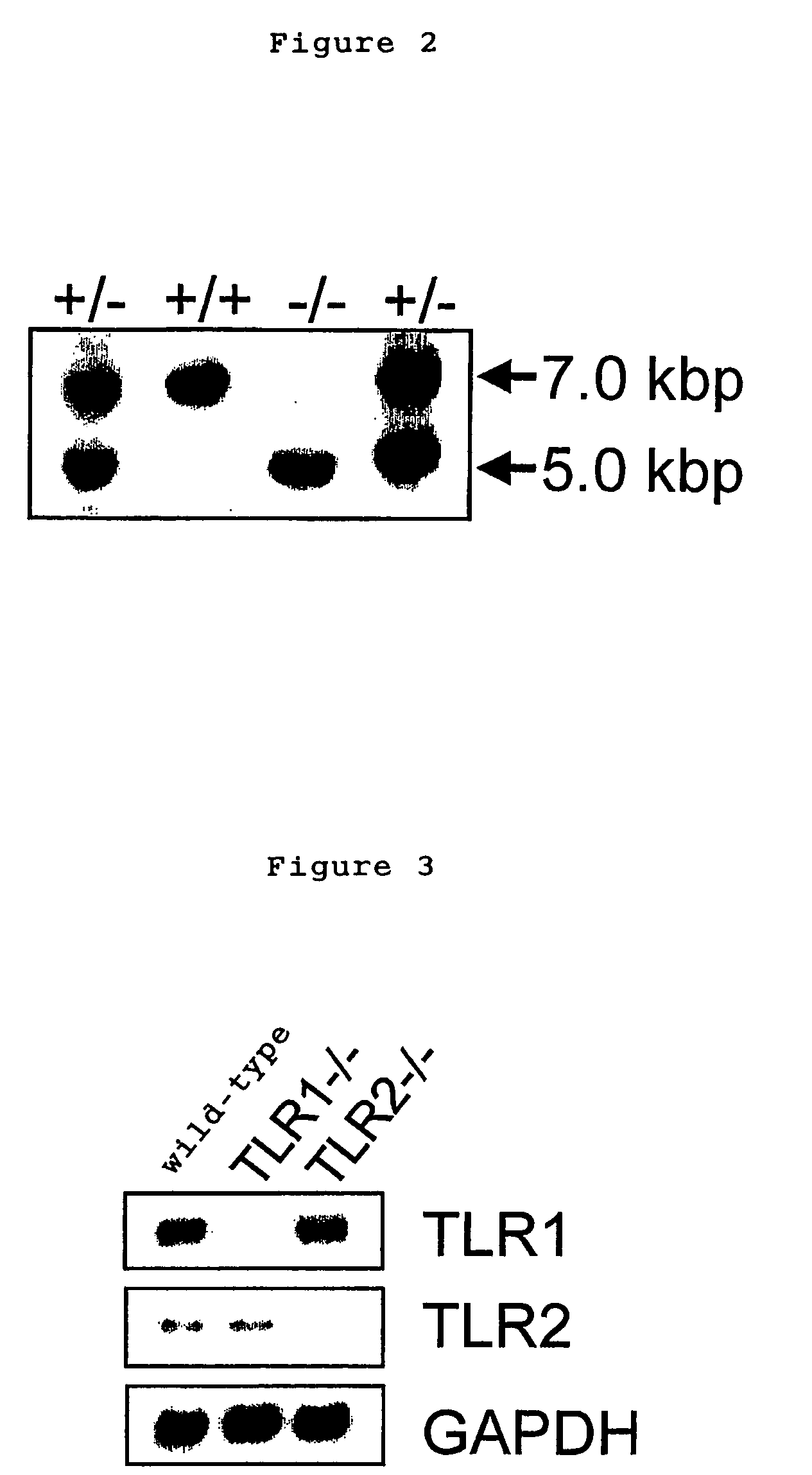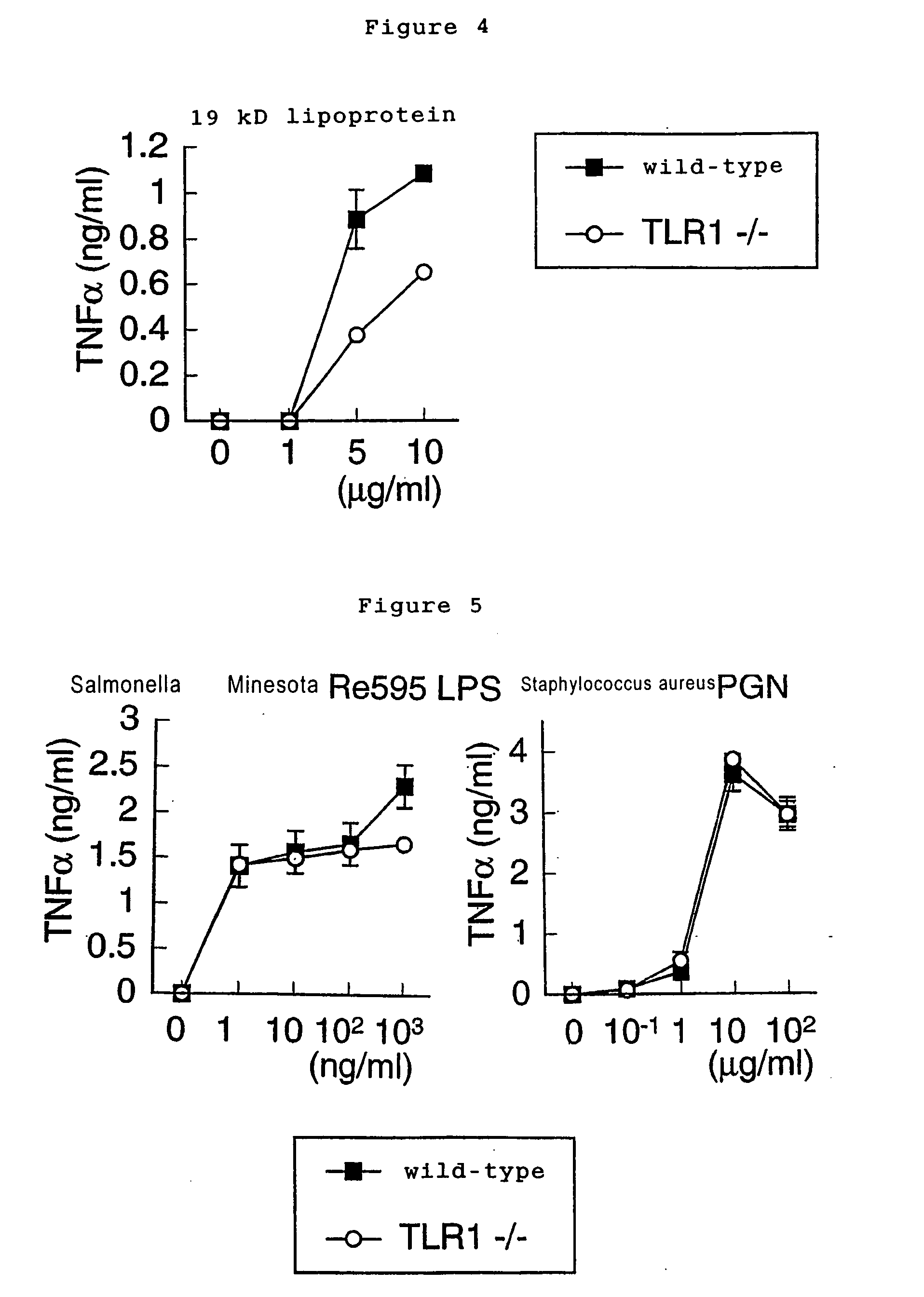Model animals non-responsive to mycobacteria-origin lipoprotein/lipopeptide
a technology of lipoproteins and mycobacterial origins, applied in the field of non-human animal models that are not responsive to mycobacterial lipoproteins/lipopeptides, can solve the problem that no protein specifically recognizing mycobacterial lipoproteins/lipopeptides is known
- Summary
- Abstract
- Description
- Claims
- Application Information
AI Technical Summary
Benefits of technology
Problems solved by technology
Method used
Image
Examples
example 1
(Preparation of TLR1 Knockout Mice)
[0045] TLR1 genes were screened from 129Sv murine genomic library (Clontech) by using a probe derived from mouse TLR1 gene, subcloned in pBluescript II SK(+) vector and were identified by restriction enzyme mapping and DNA sequence determination. A targeting vector was constructed by replacing a gene site encoding mouse TLR1 intracellular domain and transmembrane domain (1.0 kB of the 5′ end and 10 kb of the 3′ end of a portion of an exon containing amino acid 575-795 of the mouse TLR1) with a neomycin cassette (Stratagene), and by introducing herpes simplex virus thymidine kinase (HSV-TK) as a negative selection marker (FIG. 1). The targeting vector was linealized with SalI, electroporated into E14.1 embryonic stem cells (ES cells). 125 clones showing resistance to G418 and gancyclovir were selected and three clones were screened by PCR and Southern blot methods.
[0046] Three targeted ES clones containing mutant TLR1 allele were microinjected in...
example 2
(Preparation of Peritoneal Macrophages and Enzyme Linked Immunosorbent Assay)
[0047] 2 ml of 4% thioglycollate medium (DIFCO) were intraperitoneally injected into wild-type mice, TLR1 knockout (TLR1- / -) and TLR2 knockout (TLR2- / -) mice. Three days later, peritoneal exudate cells were isolated from each peritoneal cavity. The cells were cultured for 2 h at 37° C. in RPMI 1640 medium (Nacalaitesque) supplemented with 10% fetal bovine serum, cultured peritoneal macrophages (5×104) and were stimulated with indicated bacterial components such as lipoprotein for 24 h. Concentration of TNFα (Genzyme Techne) and IL-6 (R&D) in culture supernatants were determined by enzyme linked immunosorbent assay (ELISA).
(Response to PAMPs)
[0048] Native 19-kD lipoprotein purified from Mycobacterium tuberculosis (purified as described in Science 285, 732, 1999), LPS of Salmonella minnesota RE595, and PGN of Staphylococcus aureus were usedf or PAMPs. Peritoneal macrophages of wild-type and TLR1- / - mice ...
example 3
(Control of NF-κB Activity in Response to Lipopeptide Stimulation Due to Co-Expression of TLR1, TLR2 and TLR6)
[0050] HEK 293 cells were transformed with TLR1, TLR2 and TLR6 expression vectors, and pELAM-luciferase reporter plasmid were used together. For normalization of transfection efficiency by lipofectamine 2000 (Invitrogen), the indicated vector was used with pELAM-luciferase reporter plasmid (J. Bio. Chem. 274, 10689, 1999) and pRL-TK (Promega) to transfect transiently human fetal kidney (HFK)-293 cells. 24 h after transfection, the cells were stimulated with 10 ng / ml of Pam3CSK4 for 8 h. Then, the cells were lysed, and luciferase activity was measured by using Dual-luciferase reporter assay system (Promega) according to the manufacturer's instruction. The results are shown in FIG. 10. The expression of TLR2 conferred the NF-κB activation in response to Pam3CSK4 stimulation, and co-expression of TLR1 significantly enhanced the activation. In contrast, co-expression of TLR6 a...
PUM
| Property | Measurement | Unit |
|---|---|---|
| concentration | aaaaa | aaaaa |
| concentration | aaaaa | aaaaa |
| pH | aaaaa | aaaaa |
Abstract
Description
Claims
Application Information
 Login to View More
Login to View More - R&D
- Intellectual Property
- Life Sciences
- Materials
- Tech Scout
- Unparalleled Data Quality
- Higher Quality Content
- 60% Fewer Hallucinations
Browse by: Latest US Patents, China's latest patents, Technical Efficacy Thesaurus, Application Domain, Technology Topic, Popular Technical Reports.
© 2025 PatSnap. All rights reserved.Legal|Privacy policy|Modern Slavery Act Transparency Statement|Sitemap|About US| Contact US: help@patsnap.com



